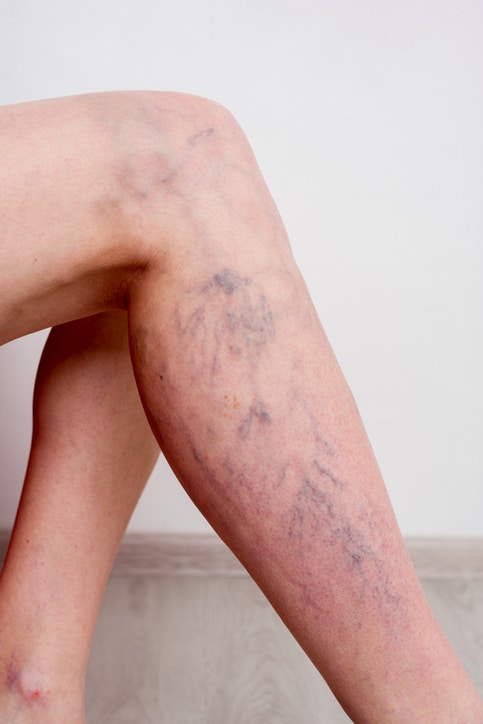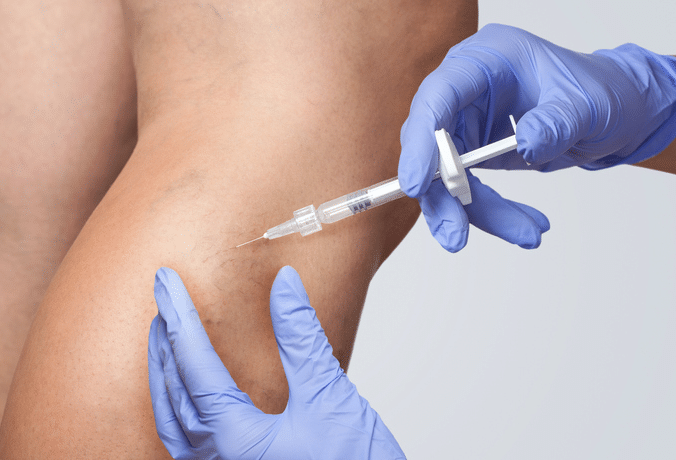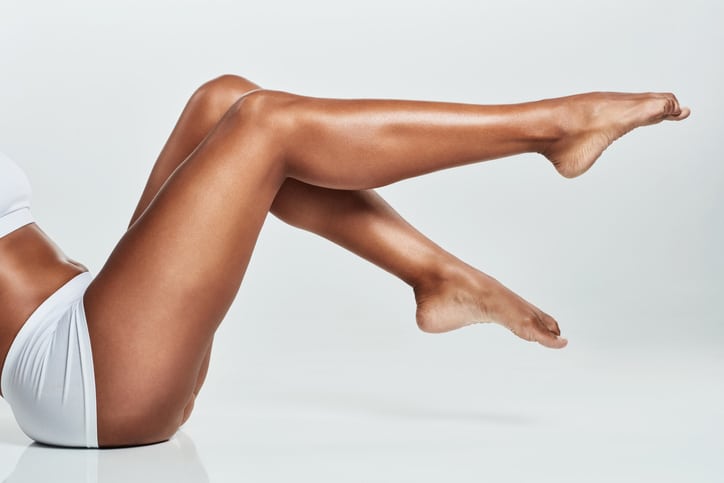
Sclerotherapy is a minimally invasive medical procedure used to treat varicose and spider veins, most commonly found on the legs, by collapsing them through the use of a solvent. Sclerotherapy has been used on patients since the 1930s with great success, producing increasingly effective medical, as well as cosmetic, results.
Who is a candidate for sclerotherapy?
Sclerotherapy is a simple procedure. It takes just a few minutes for our doctors to treat a series of veins. If you have unsightly spider veins, there aren’t really any restrictions on these procedures. Reactions to the sclerosant are virtually nonexistent.
Sclerotherapy does not work on larger varicose veins, the veins that push the skin upward. Too much sclerosant would be required. These veins must be treated with laser therapy or radiofrequency ablation or with manual vein stripping.
The Causes of Spider Veins
As we age, everything on our body seems to slacken and become a little weaker. In our legs, this matters for the de-oxygenated blood that is returning to the heart through our veins. The veins have to fight gravity the entire way, and they rely on the muscles and tissues in the legs to help push the blood upward. With age, the leg tissues and muscles, as well as the vein walls themselves, can become less rigid. Plus, the veins have valves in them to prevent backflow, and these can begin to malfunction. The result of these factors is that blood can pool in places, usually near the valves. When this happens, veins near the skin surface can become visible. The smaller, clustered veins are spider veins. The larger veins that can even push up the skin surface are known as varicose veins.
Reasons For Sclerotherapy
Some of the reasons a patient may desire, or a physician may recommend, sclerotherapy may include one or more of the following symptoms:
- Pain, aching or burning sensations in the legs or feet
- Swelling or redness at the site
- Cramping of the legs, especially at night
- Scaly, dry or discolored skin at the site
- Discomfort after sitting or standing for long periods
Individuals troubled by varicose veins may choose, in consultation with their physician, to undergo sclerotherapy either because they find them unattractive or because the diseased veins are causing unpleasant and/or dangerous symptoms.

How is the Sclerotherapy Procedure performed?

During sclerotherapy, a solution of saline and a sclerosant is injected into the damaged veins. This will cause irritation in the effected veins and produce their eventual collapse. During this procedure, the surgeon is guided through the use of ultrasound to ensure precision.When the weakened veins collapse, they will be reabsorbed into the body and other healthier veins will take their place in the circulatory system.
Sclerotherapy has proven to be a safe procedure and is performed outpatient in the doctor’s office. Typically, sclerotherapy is performed in less than an hour, although a varying number of injections may be required, depending on the number of veins involved. Patients do not require an anesthetic and usually report little or no discomfort during the procedure, only a mild burning sensation. In some instances, several sclerotherapy treatments may be necessary.
How long does treatment take, and will I need additional treatments?
A sclerotherapy session at Minimally Invasive Vascular Center is fast, taking just 15-20 minutes in most cases. We can treat multiple spider veins in a single session. One treatment usually removes the vein, but occasionally a larger vein may need a second treatment.
Recovery From Sclerotherapy
Patients are able to return home shortly after sclerotherapy. Most can return to work and resume normal activities the next day, although exercise and strenuous activities are to be avoided a week or two. Compression bandages usually need to be worn for a week or so after the procedure. While it may take up to a month for the patient to see full results, some improvement is usually visible immediately.
In order to promote vascular health and to preserve the positive effects of the sclerotherapy, it is recommended that patients maintain a healthy weight and make exercise part of their daily routine.
Is there any downtime after having sclerotherapy for spider veins?
There isn’t any real downtime. You can walk and light exercise is fine. Anything overly strenuous probably should wait a few days, particularly if we’ve closed off a number of spider veins. If we have treated multiple veins, we’ll likely have you wear compression stockings after your sclerotherapy session. The compression provided by this hosiery improves your body’s ability to heal and absorb the closed off spider veins. A MIVC doctor will recommend you wear these for up to two weeks.

In order to promote vascular health and to preserve the positive effects of the sclerotherapy, it is recommended that patients maintain a healthy weight and make exercise part of their daily routine.
Potential complications with sclerotherapy?
Sclerotherapy was first developed in the 1930s and it remains the best treatment for spider veins. Through all of these years, it has been used on millions of veins around the globe and proven to be safe and effective. There is a very low risk of reaction to the sclerosant solution. You may also have some slight redness and irritation at the injection sites, but this passes quickly. These are safe, effective treatments to get rid of your annoying spider veins.
Although sclerotherapy is a safe procedure that has been successfully performed for many years, there are certain risks associated with any medical procedure. Certain minimal, temporary side effects are to be expected, including bruising and discoloration. More serious complications are rare, but may include:
Inflammation
Swelling, warmth and discomfort around the injection site may indicate the presence of an infection for which the doctor may prescribe antibiotics.
Blood Clot
A lump of clotted blood may form in a treated vein and require drainage. Rarely, a deeper blood clot may develop, known as a deep vein thrombosis. Since there is danger that such a clot will break off and travel to the chest, resulting in a pulmonary embolism, such a clot requires urgent medical attention. Sudden shortness of breath, chest pain, dizziness or the coughing up of foamy blood are signs of pulmonary embolism and must be addressed immediately.
Air Bubbles
Tiny air bubbles may rise in the bloodstream. These may not result in any symptoms, but if the patient experiences visual disturbances, headache, coughing or nausea, the physician should be contacted.
Nerve Damage
Numbness or odd sensations in the effected limb following sclerotherapy should always be investigated.
While rare, it’s possible for a patient to have a severe allergic reaction to the sclerosant used in the treatment.
Are sclerotherapy results permanent?
Yes, when the sclerosant agent reacts with the vein, the vein wall collapses and closes off the vein. This vein is now unused, and the body will scavenge and get rid of it. While the treated veins are gone for good, that does not mean you cannot develop new spider veins.
Can I have sclerotherapy while I am pregnant?
Pregnancy exacerbates the pressure that can cause spider veins. When you have delivered your child, your legs and their spider veins will relax, and they may resolve on their own. Regardless, at the Minimally Invasive Vascular Center, as a precautionary measure, we do not provide sclerotherapy on pregnant women, nor do any reputable practitioners.
What to expect from a spider vein consultation in Laurel, MD

Your consultation is a back-and-forth flow of information. First, you’ll detail the veins you’d like to remove. An MIVC doctor will then examine them to see if sclerotherapy can be effective on them. As mentioned above, some larger veins may not be appropriate for sclerotherapy. Otherwise, we’ll discuss the procedure and what steps you can take moving forward to help preclude the development of new spider veins in the future. Throughout the meeting, you’re encouraged to ask any and all questions you may have.
Schedule An Appointment at our Laurel, MD office Today!
If you’re interested in learning more about sclerotherapy and treatment for varicose veins, please contact us for a consultation at (855) 803-6482 or fill out our contact us form below. We will discuss your needs and concerns, and determine your best course of action.


Monday – Thursday: 9am – 5pm
Friday: 9am – 1pm
Saturday – Sunday: Closed